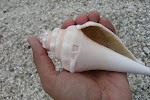One of the people I “talk stories” on biology with is a good friend and former colleague Dr. John S. He looked up in the Micronesica (the University of Guam journal of natural sciences of Micronesia and the region) to find that we have have present in CNMI waters: S. varius, S. multimuricatus, S. nicobaricus, S. squamosus and S. violascense. At times I wonder if I should have been a taxonomist because of the way I want to catalog/classify things in nature. You see, I want to be sharp enough to pick up any Spondylus shell fragment and say to a certainty that this is what it is. I know: NERD!
So how does this all translate to the pendants that make? Again, the classical Spondylus salape’ are mostly orange and I experimented with other fragments that I found that are what I call non-classical in color.
I call this salape’, Korason, the Chamorro/Spanish word for heart. It has a beautifully striated red color. The toggle is from a smaller fragment that I found that matched Korason’s colors surprisingly well.


This next piece is Papakyo, which means stormy in Chamorro. The word pakyo is very similar to bagyo, the Tagalong word of the same meaning, which hints to the Austronesian language link between the Mariana Islands and my mother islands of the Philippines. I am sure that Papakyo is a Spondylus squamosus which has an unmistakable dark maroon color. I picked up this shell fragment after a small tropical disturbance in the area hence the name. Papakyo has a rectangular toggle cut from the same shell fragment.


The piece below I named Putitainobiu after the Chamorro name for the flower Bougainvillea (puti=pain, tai=not have, nobiu=lover). I used to paint acrylics a lot and orange was a difficult color for me to utilize. I am convinced that only the Creator, the Master Artisan himself, can put pink and orange together and make it work this beautifully.

One day I was cutting a beautifully colored shell fragment with soft pink and white striations. In handling it, I knew this piece would polish quite nicely. My mind raced though, troubled by some odd news and some deep wounds caused by the remembrance of a recent break up. Although I was outside on a beautiful day, under the shade of a kind mango tree and a light breeze cooling my bare skin, my cutting was disturbed by what was effectively turmoil inside. I knew I had to calm myself down and focus on the task of creating.
Anyway, although in cutting an inanimate object such as a shell fragment is not the same, I tend to apply the same personal theory. I’d like to approach the art of creating like a Zen Japanese sword smith who undertook their task with great solemnity, and purity of heart and mind, undergoing fasting and ritual purification before laboring in the art of metallurgy. Well, my mind should at the least be clear and positive anyway.
So anyway while cutting this particular piece, thinking about a friend who came back from vacation as a single woman really bugged me. I took it a bit to heart since I at the time was mending a broken heart and although I never really met the former nobiu, I thought their relationship was all good. It made me think of how fragile relationships really are and how many things could go wrong. But I know that there are reasons for breakups and they are usually for good reasons. I had to dig deep to not be so bothered and accept things that I couldn’t do anything about really.
So how did I get rid of the internal drama and perform the task at hand? I focused on who my friend was. Although we don’t spend a lot of time together, I know that she is special. I firsthand see that she is well loved by colleagues, the kids that she teaches, the drama team she’s a part of, and so on. I think they also call her, the Northstar, since her unwavering character is a good reminder to all of us what beauty really is inside and out. She is a real beauty, as is this piece of salape’ that I made with her in mind. This one is called Mai-Rhea. Isn’t she lovely?

 Thanks again for letting me share.
Thanks again for letting me share.








